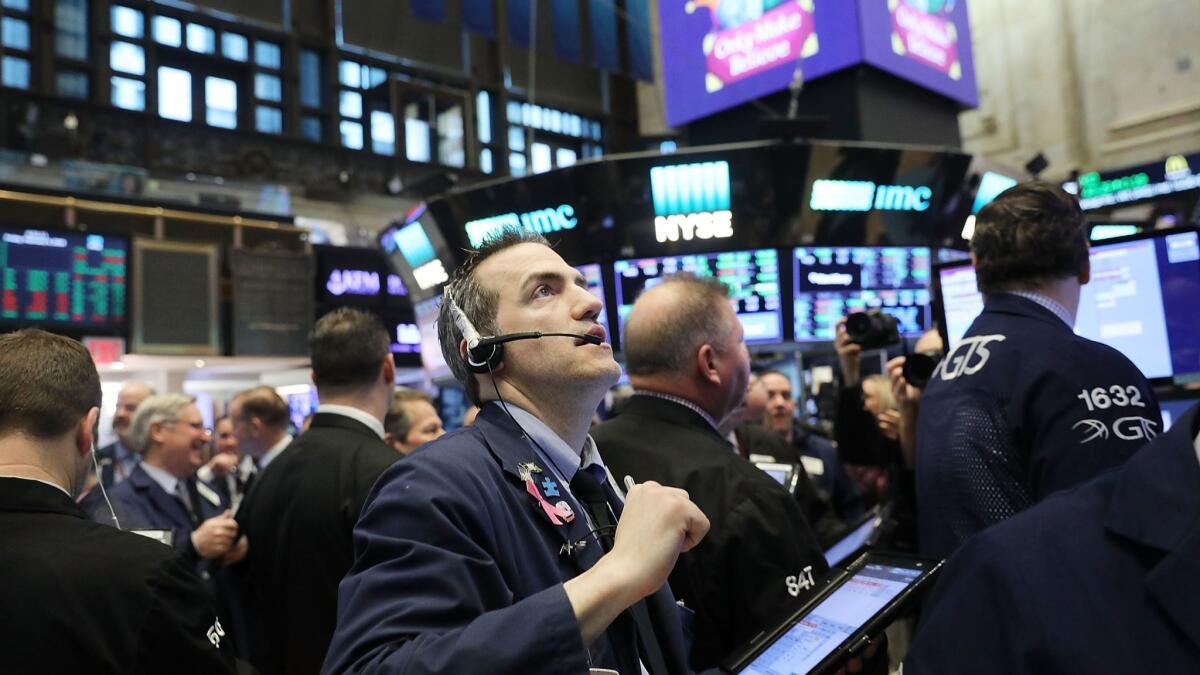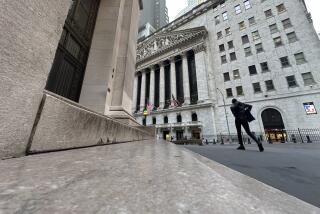Dow rises 330 points Friday, but stocks still have worst week in two years

Wall Street capped a day of wild swings Friday with a rally that reversed steep early losses and sent the Dow Jones industrial average to a gain of 330 points. Even with the rebound, this was the worst week for the market in about two years.
Stocks struggled to stabilize much of the day as investors sent prices climbing, then slumping in unsteady trading a day after the market entered its first correction in two years.
The up-and-down swings followed a drop of 9% from the latest record highs set by major U.S. indexes just two weeks ago. At the middle of the session, the market was on pace for its worst weekly decline since October 2008, at the height of the financial crisis.
The Dow briefly sank 500 points in afternoon trading after surging more than 349 points earlier in the day. The blue-chip average suffered its second 1,000-point drop in a week Thursday.
The Standard & Poor’s 500 index, the benchmark for many index funds, also wavered between gains and losses.
As of Thursday, some $2.49 trillion in value had vanished from the index since its Jan. 26 peak, according to S&P Dow Jones Indices.
“Equities have traded in a roller-coaster fashion all week, and today is no exception,” said Terry Sandven, chief equity strategist at U.S. Bank Wealth Management. “There’s a fair amount of volatility in the market, and our belief is the volatility is leaving investors riddled with stress and uncertainty, which is likely to continue.”
The S&P 500 rose 38.55 points, or 1.5%, to 2,619.55 on Friday. The Dow climbed 330.44 points, or 1.4%, to 24,190.90. The Nasdaq composite advanced 97.33 points, or 1.4%, to 6,874.49. The indexes all were down more than 5% for the week.
Technology companies accounted for most of Friday’s broad gains. That outweighed losses in energy stocks, which slumped as U.S. crude prices declined, sending the price of oil below $60 a barrel for the first time this year.
Bond prices fell. The yield on the 10-year Treasury rose to 2.85% from 2.83%.
Some companies rose after reporting quarterly results and outlooks that beat Wall Street’s forecasts. Skechers USA climbed 7.5% to $41.06. Chip maker Nvidia advanced 6.7% to $232.08.
Expedia slumped 15.5% to $104 after its latest earnings fell short of analysts’ expectations. The travel website’s 2018 outlook also disappointed.
The turbulence in U.S. stock indexes followed a broad slide in global markets.
In Europe, Germany’s DAX fell 1.2%, France’s CAC 40 lost 1.4%, and Britain’s FTSE 100 shed 1.1%. Asian markets fell more sharply. Tokyo’s Nikkei 225 lost 2.3%, and Hong Kong’s Hang Seng sank 3.1%.
U.S. stocks started to tumble last week after the Labor Department said workers’ wages grew at a fast rate in January.
Investors worried that rising wages will hurt corporate profits and could signal an increase in inflation that could prompt the Federal Reserve to raise interest rates at a faster pace, putting a brake on the economy.
On Wall Street, many companies that rose the most over the last year have borne the brunt of the selling. Facebook and Boeing have both fallen sharply.
Financial analysts regard corrections as normal events, but they say the latest unusually abrupt plunge might have been triggered by a combination of events that rattled investors. Those include worries about a potential rise in U.S. inflation or interest rates and budget disputes in Washington.
The market, currently in its second-longest bull run of all time, had not seen a correction in two years, an unusually long time. Many market watchers have been predicting a pullback, saying stock prices have become too expensive relative to company earnings.
What many failed to predict, however, was how fast the slide would go. The S&P 500 dived from a record high on Jan. 26 to a drop of 9% below that mark Thursday.
“The S&P 500 hasn’t moved into correction mode this quickly, ever,” said Lindsey Bell, investment strategist at CFRA Research. It’s taken nine days to go from the Jan. 26 peak to where we are today.”
American employers are hiring at a healthy pace, with unemployment at a 17-year low of 4.1%. The housing industry is solid, and manufacturing is rebounding.
Major economies around the world are growing in tandem for the first time since the Great Recession, and corporate profits are on the rise. That combination usually carries stocks higher. But stock prices have climbed faster than profits in recent years.
Many investors justified that by pointing out that interest rates were low and few alternatives looked like better investments. Quickly rising interest rates would make that argument much less persuasive.
In currency markets, the dollar fell to 108.68 yen from Thursday’s 108.84 yen. The euro slipped to $1.2229 from $1.2263.
Benchmark U.S. crude fell $1.95, or 3.2%, to settle at $59.20 a barrel on the New York Mercantile Exchange. Oil hadn’t been below $60 a barrel since Dec. 28. Brent crude, used to price international oils, slid $2.02, or 3.1%, to $62.79 in London.
The price of gold declined $3.30, or 0.3%, to $1,315.70 an ounce. Silver fell 20 cents, or 1.2%, to $16.14 an ounce. Copper fell 5 cents to $3.03 a pound.
UPDATES:
3:15 p.m.: This article was updated with currencies and commodities.
1:55 p.m.: This article was updated with closing prices, more context and new analyst comments.
1:05 p.m.: This article was updated with the close of markets.
8 a.m.: This article was updated with additional details about stock indexes.
7:40 a.m.: This article was updated with details about bond prices and global markets.
6:55 a.m.: This article was updated with Los Angeles Times staff reporting.
This article was originally published at 6:35 a.m.
More to Read
Inside the business of entertainment
The Wide Shot brings you news, analysis and insights on everything from streaming wars to production — and what it all means for the future.
You may occasionally receive promotional content from the Los Angeles Times.










